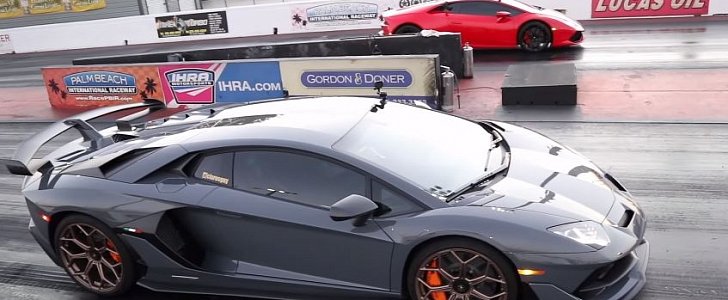The Lamborghini Aventador and the Huracan have always been close in terms of straight-line performance, so can the SVJ incarnation of the latter change that?
Here's a word of advice for anybody that happens to sit behind the wheel of the Lamborghini Aventador SVJ: perhaps it would be best not to engage in a drag race against what the world calls the standard, LP610-4 Huracan.
Now, the Aventador Superveloce Jota, which is a $600,000 car (with options - you wouldn't expect customers of the limited edition to skip those, would you?) might cost double than the said Huracan, but this doesn't do all that much in terms of the quarter mile.
There might be some aficioandos who wish to see proof of such a claim. First of all, the V10 and the V12 Raging Bulls have always been close in a straight line.
Secondly, the piece of footage at the bottom of the page allows us to zoom in on a drag race between the 770 horsepower Aventador and the 610-pony Huracan.
The clip also involves a graph showcasing the G forces and the acceleration. This quickly helps us notice the Achille's heel that prevents the SVJ from making better use of its superior muscle (the two have about the same scale footpring).
It all has to do with the transmission - while Lamborghini did invest plenty of engineering into the ISR (Integrated Shift Rods) tranny of the Aventador, this remains a single-clutch unit and simply can't shift as quickly as the dual-clutch gearbox of its little brother.
Then again, you didn't need a graph for this. Simply watching the race from the V12 model's perspective shows us how this loses a tiny bit of ground with each upshift.
Then there's the launch: as highlited by the said graph, the extremely brutal Aventador SVJ takeoff, which easily leads to wheelies on the prepped surface of the drag strip, actually harms the performance, as the car struggles right after the initial impulse (you can hear this thanks to the exhaust note).
In fact, these are the tires that recently helped another stock Huracan set a quarter-mile world record, with a time of 10.41 seconds.
So, if you were planning to get an Aventador because it has more power, save yourself some cash and.... ah, who an I kidding? Nobody buys the V12 model just for that.
Besides, once the two pass the quarter-mile mark, the superior power-to-weight ratio of the big brother means it will get ahead. So i'll see you in the half-mile...
Now, the Aventador Superveloce Jota, which is a $600,000 car (with options - you wouldn't expect customers of the limited edition to skip those, would you?) might cost double than the said Huracan, but this doesn't do all that much in terms of the quarter mile.
There might be some aficioandos who wish to see proof of such a claim. First of all, the V10 and the V12 Raging Bulls have always been close in a straight line.
Secondly, the piece of footage at the bottom of the page allows us to zoom in on a drag race between the 770 horsepower Aventador and the 610-pony Huracan.
The clip also involves a graph showcasing the G forces and the acceleration. This quickly helps us notice the Achille's heel that prevents the SVJ from making better use of its superior muscle (the two have about the same scale footpring).
It all has to do with the transmission - while Lamborghini did invest plenty of engineering into the ISR (Integrated Shift Rods) tranny of the Aventador, this remains a single-clutch unit and simply can't shift as quickly as the dual-clutch gearbox of its little brother.
Then again, you didn't need a graph for this. Simply watching the race from the V12 model's perspective shows us how this loses a tiny bit of ground with each upshift.
Then there's the launch: as highlited by the said graph, the extremely brutal Aventador SVJ takeoff, which easily leads to wheelies on the prepped surface of the drag strip, actually harms the performance, as the car struggles right after the initial impulse (you can hear this thanks to the exhaust note).
But wait
And while this Huracan is reportedly stock, I have to mention its rides on Toyo R888R tires, which do perform better than the factory rubber at the drag strip.In fact, these are the tires that recently helped another stock Huracan set a quarter-mile world record, with a time of 10.41 seconds.
What can an aficioando do?
From behind the wheel, the start and the shifts of the ISR tranny feel considerably spicier than the ones delivered by the DCT unit on the Huracan and on the street this is what matters. No, really, the original LP700-4 Aventador was the only test car that made our photographer run and duck for cover as it was attempting a Launch Control shenanigan.So, if you were planning to get an Aventador because it has more power, save yourself some cash and.... ah, who an I kidding? Nobody buys the V12 model just for that.
Besides, once the two pass the quarter-mile mark, the superior power-to-weight ratio of the big brother means it will get ahead. So i'll see you in the half-mile...







